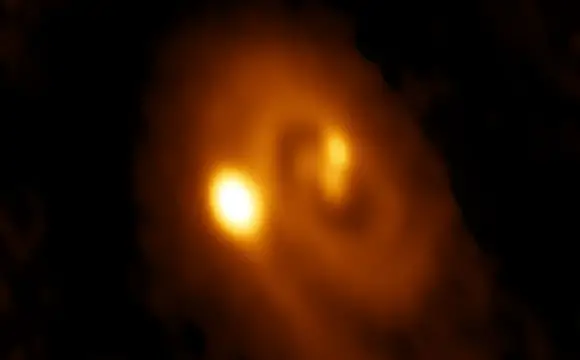International Researchers Discover Feeding Mechanism in Triple Protostar System
In a groundbreaking new study, a team of international researchers has made an astonishing discovery in the field of star formation. Led by Professor Jeong-Eun Lee from Seoul National University, the team has uncovered the intricate feeding mechanism within a triple protostar system called IRAS 04239+2436. This remarkable finding sheds light on the complex processes that occur during the growth and development of stars, enhancing our understanding of the wondrous intricacies of the universe.
The Mystery of Star Formation

Stars, with their awe-inspiring brilliance and cosmic significance, have captivated human imagination for centuries. But the process by which these celestial bodies are born and grow has remained a mystery for scientists. Understanding the intricacies of star formation is crucial for unraveling the secrets of the universe and gaining insights into the fundamental laws of nature.
The Triple Protostar System
Within the vast expanse of space, the researchers focused their attention on the triple protostar system IRAS 04239+2436. Such systems provide a unique opportunity to observe the early stages of star formation and gain insights into the dynamics at play.
The Role of Sulfur Monoxide Molecules
Through their observations using the Atacama Large Millimeter/submillimeter Array (ALMA) telescopes, the team made a groundbreaking discovery. They found that the gas surrounding the three baby stars in the IRAS 04239+2436 system contains sulfur monoxide (SO) molecules.
The Presence of Shock Waves
The presence of sulfur monoxide molecules indicates the existence of shock waves within the system. These shock waves are caused by the complex interactions among the protostars, creating a dynamic environment conducive to star formation.
Understanding the Feeding Mechanism
By studying this triple protostar system, the researchers were able to unravel the feeding mechanism that supports the growth of the baby stars.
The Spiraling Gas Flows
Through an analysis of the gas flows in the system, the team discovered that the spiral arms formed by the distribution of sulfur monoxide molecules act as streamers, delivering material to the protostars. These gas flows play a crucial role in fueling the growth and sustenance of the stars.
The Role of Numerical Simulations
To further understand the gas flows and their impact, the researchers collaborated with Professor Tomoaki Matsumoto from Hosei University. His numerical simulations provided valuable insights into the velocity of the gas and its correlation to the observed flows in the system.
Implications and Future Directions

This groundbreaking discovery of the feeding mechanism in the triple protostar system IRAS 04239+2436 opens up exciting possibilities for further exploration and study in the field of star formation. By comprehending the complex dynamics at play, scientists can enhance their understanding of the evolution of triple protostar systems and gain insights into the larger cosmic processes.
Unraveling the Mysteries of the Universe
Understanding how stars are born and nurtured not only enlightens us about the wonders of the universe but also provides a deeper understanding of the fundamental laws that govern it. The discovery of the feeding mechanism in the triple protostar system marks a significant milestone in our quest to unravel the mysteries of the cosmos.
Conclusion

The international team of researchers led by Professor Jeong-Eun Lee has made a groundbreaking discovery regarding the feeding mechanism in the triple protostar system IRAS 04239+2436. This significant finding enhances our understanding of star formation processes and the interconnectedness of cosmic phenomena. As scientists continue to delve into the mysteries of the universe, such discoveries bring us one step closer to unraveling the secrets of the cosmos.
Frequently Asked Questions (FAQs)

1. How did the researchers study the triple protostar system?
The researchers studied the triple protostar system by using the Atacama Large Millimeter/submillimeter Array (ALMA) telescopes to observe the gas surrounding the stars.
2. What is the significance of sulfur monoxide molecules in the system?
The presence of sulfur monoxide molecules indicates the existence of shock waves caused by the complex interactions among the protostars, providing insights into the dynamic nature of star formation.
3. What role do numerical simulations play in understanding the feeding mechanism?
Numerical simulations conducted by Professor Tomoaki Matsumoto help correlate the observed gas flows with the velocity of the gas, providing a deeper understanding of the feeding mechanism in the triple protostar system.
4. How does this discovery contribute to our understanding of the universe?
By uncovering the feeding mechanism in the triple protostar system, this discovery enhances our understanding of star formation processes and the interconnectedness of cosmic phenomena.
5. What are the future implications of this research?
This research opens up new avenues for further exploration and study in the field of star formation, leading to advancements in our understanding of the evolutionary processes within triple protostar systems and the broader cosmic landscape.


Add Comment